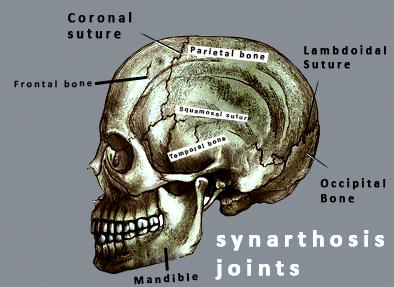
Which of the following is an immovable joint?
(a)Synarthrosis
(b)Hinge joint
(c)Gliding joint
(d)None of the above
Answer
482.1k+ views
Hint: These immovable joints are present in skull sutures, articulations between the teeth and the mandible, and the joint found between the first pair of ribs and the sternum.
Complete answer:
-An immovable joint connects the ends of the bones through tough fibrous tissue.
-Synarthrosis is a type of immovable joint present in skull sutures.
-A synarthrosis is a type of joint where there is no movement under normal conditions.
-The synarthrosis doesn’t allow any movement under normal conditions at all.
-The strong union between the articulating bones is provided due to this immobile nature of the articulating bones.
-This joint is present in locations where the bones provide protection for internal organs.
-The sutures present in the skull bones are the fibrous joints that surround and protect the brain.
-The bones present in fibrous joints are held together by fibrous connective tissue. There is no cavity, or space, between the bones, that’s why this joint is immovable.
-These joints are also present in the manubriosternal joint that is a cartilaginous joint that unites the manubrium and body of the sternum for protection of the heart.
So, the correct answer is ‘Synarthrosis’

Note: -Hinge and the gliding joints are the synovial joints.
-The gliding joints provide a gliding movement in the plane of the articular surfaces.
-Examples of gliding joints include the carpal joints of the wrist, the tarsal joints of the ankle.
-Hinge joint examples are the elbow, knee, ankle, wrist, fingers, toes, and jaw.
-Hinge joint provides movement in only one direction.
Complete answer:
-An immovable joint connects the ends of the bones through tough fibrous tissue.
-Synarthrosis is a type of immovable joint present in skull sutures.
-A synarthrosis is a type of joint where there is no movement under normal conditions.
-The synarthrosis doesn’t allow any movement under normal conditions at all.
-The strong union between the articulating bones is provided due to this immobile nature of the articulating bones.
-This joint is present in locations where the bones provide protection for internal organs.
-The sutures present in the skull bones are the fibrous joints that surround and protect the brain.
-The bones present in fibrous joints are held together by fibrous connective tissue. There is no cavity, or space, between the bones, that’s why this joint is immovable.
-These joints are also present in the manubriosternal joint that is a cartilaginous joint that unites the manubrium and body of the sternum for protection of the heart.
So, the correct answer is ‘Synarthrosis’

Note: -Hinge and the gliding joints are the synovial joints.
-The gliding joints provide a gliding movement in the plane of the articular surfaces.
-Examples of gliding joints include the carpal joints of the wrist, the tarsal joints of the ankle.
-Hinge joint examples are the elbow, knee, ankle, wrist, fingers, toes, and jaw.
-Hinge joint provides movement in only one direction.
Recently Updated Pages
Master Class 11 Economics: Engaging Questions & Answers for Success

Master Class 11 Business Studies: Engaging Questions & Answers for Success

Master Class 11 Accountancy: Engaging Questions & Answers for Success

Master Class 11 English: Engaging Questions & Answers for Success

Master Class 11 Computer Science: Engaging Questions & Answers for Success

Master Class 11 Maths: Engaging Questions & Answers for Success

Trending doubts
State and prove Bernoullis theorem class 11 physics CBSE

1 ton equals to A 100 kg B 1000 kg C 10 kg D 10000 class 11 physics CBSE

State the laws of reflection of light

One Metric ton is equal to kg A 10000 B 1000 C 100 class 11 physics CBSE

1 Quintal is equal to a 110 kg b 10 kg c 100kg d 1000 class 11 physics CBSE

Difference Between Prokaryotic Cells and Eukaryotic Cells




